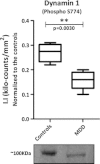Phosphoproteomic differences in major depressive disorder postmortem brains indicate effects on synaptic function
- PMID: 22350622
- PMCID: PMC3491199
- DOI: 10.1007/s00406-012-0301-3
Phosphoproteomic differences in major depressive disorder postmortem brains indicate effects on synaptic function
Abstract
There is still a lack in the molecular comprehension of major depressive disorder (MDD) although this condition affects approximately 10% of the world population. Protein phosphorylation is a posttranslational modification that regulates approximately one-third of the human proteins involved in a range of cellular and biological processes such as cellular signaling. Whereas phosphoproteome studies have been carried out extensively in cancer research, few such investigations have been carried out in studies of psychiatric disorders. Here, we present a comparative phosphoproteome analysis of postmortem dorsolateral prefrontal cortex tissues from 24 MDD patients and 12 control donors. Tissue extracts were analyzed using liquid chromatography mass spectrometry in a data-independent manner (LC-MS(E)). Our analyses resulted in the identification of 5,195 phosphopeptides, corresponding to 802 non-redundant proteins. Ninety of these proteins showed differential levels of phosphorylation in tissues from MDD subjects compared to controls, being 20 differentially phosphorylated in at least 2 peptides. The majority of these phosphorylated proteins were associated with synaptic transmission and cellular architecture not only pointing out potential biomarker candidates but mainly shedding light to the comprehension of MDD pathobiology.
Figures




Similar articles
-
Identification of proteomic signatures associated with depression and psychotic depression in post-mortem brains from major depression patients.Transl Psychiatry. 2012 Mar 13;2(3):e87. doi: 10.1038/tp.2012.13. Transl Psychiatry. 2012. PMID: 22832852 Free PMC article.
-
Quantitative Phosphoproteomic Analysis of Brain Tissues.Methods Mol Biol. 2017;1598:199-211. doi: 10.1007/978-1-4939-6952-4_8. Methods Mol Biol. 2017. PMID: 28508362
-
An association between the reduced levels of SLC1A2 and GAD1 in the dorsolateral prefrontal cortex in major depressive disorder: possible involvement of an attenuated RAF/MEK/ERK signaling pathway.J Neural Transm (Vienna). 2014 Jul;121(7):783-92. doi: 10.1007/s00702-014-1189-z. Epub 2014 Mar 22. J Neural Transm (Vienna). 2014. PMID: 24652383
-
Relationship between neurotoxic kynurenine metabolites and reductions in right medial prefrontal cortical thickness in major depressive disorder.Brain Behav Immun. 2016 Mar;53:39-48. doi: 10.1016/j.bbi.2015.11.003. Epub 2015 Nov 4. Brain Behav Immun. 2016. PMID: 26546831 Free PMC article.
-
Major depressive disorder: insight into candidate cerebrospinal fluid protein biomarkers from proteomics studies.Expert Rev Proteomics. 2017 Jun;14(6):499-514. doi: 10.1080/14789450.2017.1336435. Expert Rev Proteomics. 2017. PMID: 28562112 Review.
Cited by
-
Proteomic and Microscopic Strategies towards the Analysis of the Cytoskeletal Networks in Major Neuropsychiatric Disorders.Int J Mol Sci. 2016 Apr 20;17(4):581. doi: 10.3390/ijms17040581. Int J Mol Sci. 2016. PMID: 27104521 Free PMC article. Review.
-
The Energy Metabolism Dysfunction in Psychiatric Disorders Postmortem Brains: Focus on Proteomic Evidence.Front Neurosci. 2017 Sep 7;11:493. doi: 10.3389/fnins.2017.00493. eCollection 2017. Front Neurosci. 2017. PMID: 28936160 Free PMC article. Review.
-
Cell-Type-Specific Neuroproteomics of Synapses.Biomolecules. 2023 Jun 16;13(6):998. doi: 10.3390/biom13060998. Biomolecules. 2023. PMID: 37371578 Free PMC article. Review.
-
What Have Mass Spectrometry-Based Proteomics and Metabolomics (Not) Taught Us about Psychiatric Disorders?Mol Neuropsychiatry. 2015 Jul;1(2):69-75. doi: 10.1159/000381902. Epub 2015 May 12. Mol Neuropsychiatry. 2015. PMID: 27602358 Free PMC article. Review.
-
Neuroprotective Activity of Grape Seed and Skin Extract Against Lithium Exposure Using Proteomic Research.Mol Neurobiol. 2017 May;54(4):2720-2730. doi: 10.1007/s12035-016-9853-y. Epub 2016 Mar 21. Mol Neurobiol. 2017. PMID: 27000838
References
-
- Benjamini Y, Hochberg Y. Controlling the false discovery rate: a practical and powerful approach to multiple testing. J R Stat Soc. 1995;57:289–300.
Publication types
MeSH terms
Substances
LinkOut - more resources
Full Text Sources
Molecular Biology Databases

